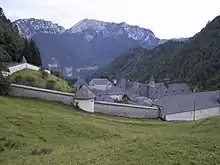Grande Chartreuse
Grande Chartreuse (French: [ɡʁɑ̃d ʃaʁtʁøz]) is the head monastery of the Carthusian religious order. It is located in the Chartreuse Mountains, north of the city of Grenoble, in the commune of Saint-Pierre-de-Chartreuse (Isère), France.

History
_(14782052354).jpg.webp)
Originally, the château belonged to the See of Grenoble. In 1084, Saint Hugh gave it to hermit Saint Bruno and his followers who founded the Carthusian Order.
The recipe of the alcoholic beverage Chartreuse is said to have been given to the monks of Grande Chartreuse in 1605[1] by the French Marshal François Annibal d'Estrées. For over a century, the monks worked on perfecting the 130-ingredient recipe. In 1764, the monks expanded their distillery for the first time to meet the demand of their popular Elixir Végétal de la Grande Chartreuse.[2] The distillery has then been moved several times in more remote areas because it represents a major explosion hazard for the surrounding habitations.[1]
The château went through many severe casualties, reconstructions and renovations. The building standing today (2021) was erected in 1688.[3] In 1790, following the French Revolution, the monks were expelled from the monastery, and waited until 1838 to be reauthorized on the premises.[2]
Following the establishment of the Association Law of 1901 and its interpretation that effectively banned religious associations en masse, many notable religious institutions across France, including Grand Chartreuse, were closed by the French government.[4] While some monks found refuge in Italy until 1929,[5] others settled in the Tarragona region of Spain and relaunched the monastery's famous a liqueur-producing activity. The Grande Chartreuse was sold in 1927 to a group of local entrepreneurs who invited the monks back in their monastery.[2]
In 1940, the Grande Chartreuse was reopened under the Pétain regime.[6] At the end of World War II, the Grand Chartreuse was used as a hospital by the Allied Forces.
Description

Visitors are not permitted at Grand Chartreuse, and motor vehicles are prohibited on the surrounding roads.
A museum of the Carthusian order and the lives of its monks and nuns is located about two kilometers away. The order is supported by the sales of Chartreuse liqueur which has been popular in France and later around the world since the early 18th century. In 2015, the order sold 1.5 million bottles of Chartreuse (50 euros a bottle), and all the proceedings went into financing the order and its charity projects.[1]
In literature
English poet Matthew Arnold wrote one of his finest poems, Stanzas from the Grande Chartreuse, while briefly staying at the monastery around 1850.[7] The quiet, serenity, and monastic calm became, for him, the susurrations of a dying world which contrasted with what he saw as the violent emerging age of machinery. Grand Chartreuse was also described by William Wordsworth in his 1792 Descriptive Sketches (lines 53-73), and in the 1850 revision of The Prelude, Book VI (lines 416-18), (Wordsworth visited the monastery in 1790, but he describes the 1792 expulsion of the monks by French forces); and John Ruskin's Praeterita.
See also
| Wikimedia Commons has media related to Grande-Chartreuse monastery. |
References
- Kait Bolongaro, An uncanny mixture: God, alcohol and even cannabis, Bbc.com, 27 October 2016
- A monks love of Chartreuse, Drinkingcup.net
- Joe Kissell, The Grande Chartreuse, Itotd.com, 29 October 2018
- "La Grande Chartreuse". Catholic Encyclopedia.
The monastery, with a small portion of the surrounding pastures, was rented from the State until the last monks were expelled by two squadrons of dragoons on the 19th of April, 1903.
- "La Grande Chartreuse". Immaculate Heart of Mary's Hermitage.
The monks of La Grand Chartreuse, driven into exile with the prior general, found refuge at Farneta, in Italy, until 1929, when Montrieux, the first of the French charterhouses to be restored, was reopened.
- "Church & Democracy". Time Magazine. Aug 19, 1940. Retrieved 2002-02-24.
Meanwhile the Holy See's endorsement of the Petain regime in France brought it minor benefits, such as the Carthusians' return to their Alpine eyrie, the Grande Chartreuse.
- Stanzas from the Grande Chartreuse
Videography
- (documentary) Into Great Silence, directed by Philip Gröning (2005)